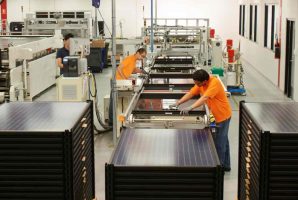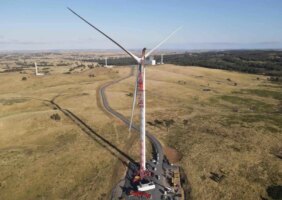The Australian Energy Market Operator looks to have performed a rare slam dunk in efforts to progress a critical grid upgrade linking Victoria and New South Wales, announcing a new preferred route for VNI West that the box on logistics, cost and social licence.
AEMO Victoria Planning, or AVP, has been working up the logistics and economics of the Victoria to New South Wales Interconnector West – also known as KerangLink – with network company Transgrid, as a vital new link between the two states that promises to unlock up gigawatts of new renewable generation capacity and tap into the massive, but delayed, Snowy 2.0 pumped hydro storage project.
Finding the right pathway for the new 500kV transmission lines, however, has proven no easy task.
To that end, AVP was just this week given the green light by the Victorian government to consider alternative routes for the project, as a way out of a planning quagmire caused by strong pushback from communities against a previously proposed connection point, north of Ballarat.
The new preferred route, set out by AEMO on Thursday, proposes a 500kV double-circuit overhead transmission line running from Bulgana in western Victoria to Dinawan in NSW via a new terminal station near Kerang.

In its new Options Assessment, AEMO says the new proposed perferred route for VNI West – dubbed Option 5 in the report – is better than the last on a number of levels, including cost (lower), consumer benefits (higher) and social and environmental constraints (fewer).
The report says moving the point of connection from the currently proposed terminal station location north of
Ballarat (Djaara Country) to Bulgana (Wotjobaluk Country) will deliver $1.39 billion of net benefits in present value terms.
One downside is that Option 5 provides the “lowest indicative improvement to REZ transmission limits of all seven options assessed,” at just under 3.5GW, while others promised to open up closer to 5GW of new hosting capacity.
Happily, an impressive number of the stakeholders involved in community negotiations on VNI West appear to agree with the market operator that the benefits of the new route outweigh the negatives.
Stephanie Bashir, a principal at Nexa Advisory that has been working with community groups during VNI West negotiations says the alternative AEMO has come out with this week solves a number of issues for communities in western Victoria, including an unreliable grid.
“Today’s report from AEMO, coupled with the announcement from the Victorian government that NEVA will be used to expedite the planning and early work for WNI West, are a welcome recognition that something urgently needs to be done,” Bashir said.
According to Nexa’s estimates in a report it put together for the Wimmera Development Association, there are around 19 renewable energy projects queuing up to be developed in the Wimmera Southern Mallee region, amounting to more than 10 gigawatts – but lack of transmission capacity has been standing in the way.
“[The new preferred route] clearly makes most sense when assessed on capacity, delivery timeframe, cost and social, environmental and cultural heritage factors,” said Bashir.
“It will now be fundamental that communities are engaged in good faith, and targeted compensation is available, to make sure VNI West and other essential infrastructure projects happen.
“Transmission is the missing link to ensuring renewable generation and storage can replace the exiting coal generation. We need to get on with building it, on a massive scale.”
In western Victoria, concerns are growing around what will happen to the power supply when the Yallourn coal power plant closes in just a few years.
“Yallourn power station is scheduled to close in 2028, removing 4GW of generation from the national grid. There is no way that the replacement generation can be become a reality without confidence in transmission capacity,” said Stuart Benjamin, chair of Grampians New Energy Taskforce (GNET) on Thursday.
“The power in the region is already unreliable, impacting families and businesses. If the right decisions are not made now, in 2028 the lights will go out.”
Chris Sounness, CEO of the Wimmera Development Association says building the essential transmission, at 500kv and in the right places, will support Australia’s net zero targets, pave the way for renewables-based electrification and enable a community to thrive.
“These projects will cost billions of dollars, but the benefits now and in the future are many multiples of the outlay, including thousands of new jobs in WSM,” Sounness said in his own statement on Thursday.
“Not only will the WSM region finally have the reliable power it needs, but we will have contributed to achieving critical steps on the road to meeting Victoria and Australia’s clean energy transition.”
Tony Goodfellow from the renewable energy consumer advocacy group RE-Alliance says the support for the new route from regional stakeholders like the WDA shows AEMO’s engagement is improving.
“It is good to see AEMO go beyond least-cost as the sole criterion and use social and environmental considerations to develop alternatives,” Goodfellow says.
“Communities should have a central say in major developments like VNI West. We welcome AEMO’s more thorough engagement plan for all stakeholders.”
VNI West is not out of the woods yet, however. The new preferred route set out in AEMO’s Consultation Report is now open to public submissions for six weeks until April 05.
In the meantime, AVP and Transgrid will hold a series of webinars, briefings and community drop-in sessions prior to submissions closing to consult further with stakeholders, Traditional Owners and communities before a final decision on the preferred option is made.
At the same time, AusNet will engage with landholders along the proposed route to provide them with the latest available information and respond to their questions and concerns about potential changes.
And, as RE-Alliance’s Goodfellow stresses, there is also the responsibility to make sure landholders receive fair compensation for hosting the new transmission infrastructure.
“Last year the NSW government introduced a policy to pay transmission line hosts $200,000 per kilometre over a 20-year period. We would like to see similar payments in Victoria,” he says.
AEMO says all feedback will be considered in the preparation of the final report (the PACR) and all written submissions will be published online, along with a summary of how feedback has been considered. It hopes, along with Transgrid, to have the PACR published in May.










